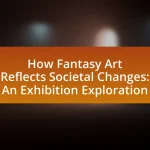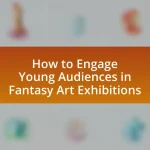A Fantasy Art Exhibition is a curated showcase of artworks that explore imaginative themes, characters, and worlds, often influenced by mythology and folklore. This article outlines the process of curating such exhibitions, highlighting the differences from traditional art displays, common themes, and the significance of fantasy art in contemporary culture. Key elements of successful curation include selecting a cohesive theme, engaging diverse artists, and creating an immersive experience for visitors. Additionally, the article addresses challenges faced during curation, strategies for effective promotion, and best practices to enhance audience engagement and inclusivity in artist selection.
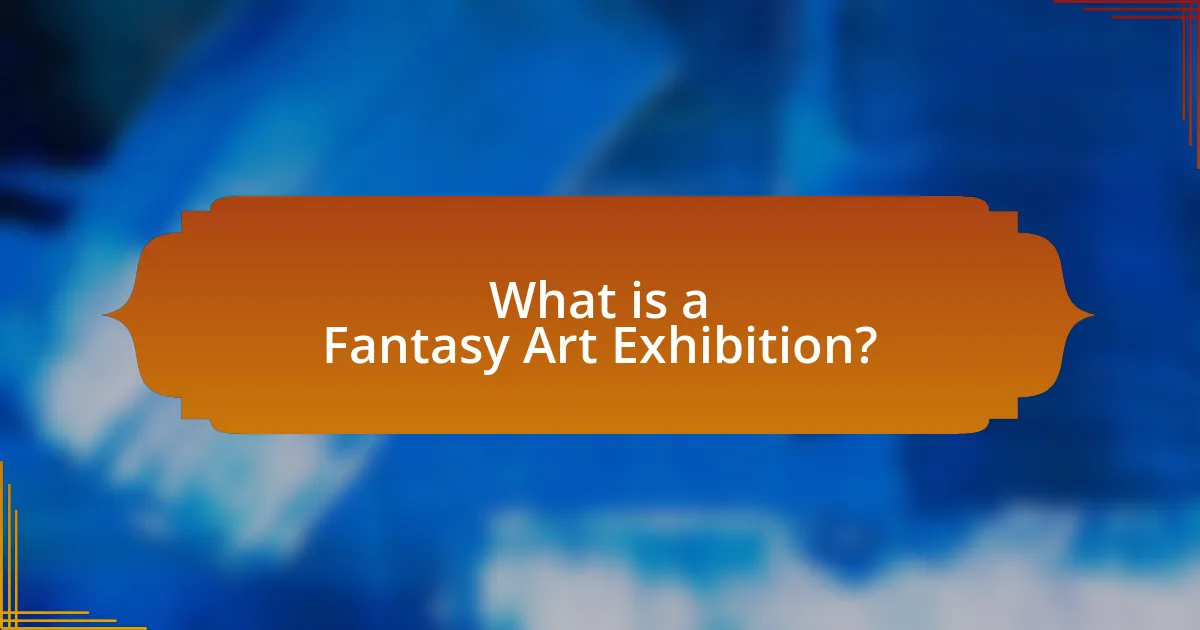
What is a Fantasy Art Exhibition?
A Fantasy Art Exhibition is a curated display of artworks that depict fantastical themes, characters, and worlds, often inspired by mythology, folklore, and imaginative storytelling. These exhibitions showcase a variety of artistic mediums, including painting, sculpture, digital art, and illustration, allowing artists to express their creativity and vision of alternate realities. The significance of such exhibitions lies in their ability to engage audiences with the imaginative aspects of art, fostering appreciation for creativity and storytelling in visual forms.
How does a Fantasy Art Exhibition differ from other art exhibitions?
A Fantasy Art Exhibition differs from other art exhibitions primarily in its thematic focus on imaginative and fantastical elements, often drawing from genres like fantasy literature, mythology, and science fiction. This type of exhibition showcases artworks that depict otherworldly scenes, mythical creatures, and surreal landscapes, which are less commonly featured in traditional art exhibitions that typically emphasize realism or historical context. For instance, while a conventional art exhibition may highlight classical techniques and historical narratives, a Fantasy Art Exhibition invites artists to explore creativity beyond the constraints of reality, often resulting in a unique blend of visual storytelling and imaginative expression.
What themes are commonly explored in Fantasy Art Exhibitions?
Common themes explored in Fantasy Art Exhibitions include mythology, magic, and alternate realities. These themes often draw inspiration from folklore, literature, and popular culture, showcasing fantastical creatures, heroic quests, and surreal landscapes. For instance, many exhibitions feature works that reinterpret classic myths or create entirely new mythologies, reflecting cultural narratives and human experiences. Additionally, the theme of magic is prevalent, often depicted through vibrant colors and imaginative compositions that evoke a sense of wonder. Alternate realities are also a significant focus, allowing artists to explore concepts of parallel worlds and dreamlike scenarios, which challenge viewers’ perceptions of reality.
Why is fantasy art significant in contemporary culture?
Fantasy art is significant in contemporary culture because it serves as a powerful medium for self-expression and escapism, allowing individuals to explore complex themes and emotions through imaginative visuals. This genre often reflects societal issues, such as identity, conflict, and environmental concerns, enabling artists to comment on and critique the world around them. For instance, the rise of digital platforms has democratized access to fantasy art, fostering diverse voices and perspectives that resonate with a global audience. Additionally, the popularity of fantasy art in films, video games, and literature underscores its cultural relevance, as it shapes collective narratives and influences trends in various creative industries.
What are the key elements of curating a Fantasy Art Exhibition?
The key elements of curating a Fantasy Art Exhibition include selecting a cohesive theme, choosing diverse artworks, engaging with artists, designing the exhibition space, and creating educational materials. A cohesive theme ensures that all pieces resonate with the fantasy genre, while diverse artworks showcase various styles and interpretations, appealing to a broader audience. Engaging with artists fosters collaboration and can enhance the exhibition’s authenticity. Designing the exhibition space involves thoughtful layout and lighting to enhance the viewer’s experience. Lastly, educational materials, such as labels and brochures, provide context and deepen the audience’s understanding of the artworks and the fantasy genre.
How do you select the right artists for the exhibition?
To select the right artists for the exhibition, curators evaluate the artists’ portfolios, artistic styles, and thematic relevance to the exhibition’s concept. This process involves reviewing previous works to ensure they align with the exhibition’s vision and resonate with the target audience. Additionally, curators may consider the artists’ reputations, exhibition history, and ability to engage with the audience, which can enhance the overall impact of the exhibition. For instance, successful exhibitions often feature artists whose works have previously garnered critical acclaim or audience interest, thereby validating the selection process.
What role does the exhibition space play in the overall experience?
The exhibition space significantly influences the overall experience by shaping how visitors perceive and interact with the art. A well-designed space enhances engagement, guiding the viewer’s journey through the exhibition and creating an immersive environment that complements the artwork. For instance, studies show that spatial arrangement and lighting can affect emotional responses, with research indicating that 70% of visitors report a stronger connection to art in thoughtfully curated spaces. This demonstrates that the exhibition space is not merely a backdrop but a critical component that enhances the narrative and emotional impact of the displayed works.
What challenges might arise when curating a Fantasy Art Exhibition?
Curating a Fantasy Art Exhibition presents several challenges, including sourcing diverse artworks, ensuring thematic coherence, and managing logistical issues. Sourcing diverse artworks can be difficult due to the niche nature of fantasy art, which may limit available pieces and artists. Ensuring thematic coherence requires a clear vision to connect various artworks, as fantasy encompasses a wide range of styles and interpretations. Logistical issues, such as space constraints, installation requirements, and transportation of fragile pieces, can complicate the exhibition process. These challenges necessitate careful planning and collaboration with artists and stakeholders to create a successful exhibition.
How can budget constraints impact the curation process?
Budget constraints can significantly limit the curation process by restricting the selection of artworks, venues, and promotional activities. When financial resources are limited, curators may have to prioritize lower-cost pieces or artists, which can affect the overall quality and diversity of the exhibition. For instance, a study by the National Endowment for the Arts found that budget limitations often lead to fewer exhibitions and reduced opportunities for emerging artists, thereby narrowing the scope of artistic expression presented to the audience. Additionally, budget constraints can hinder marketing efforts, resulting in lower attendance and engagement, which further impacts the success of the exhibition.
What strategies can be employed to overcome logistical challenges?
To overcome logistical challenges in curating a fantasy art exhibition, employing detailed planning and effective communication is essential. Detailed planning involves creating a comprehensive timeline that outlines all tasks, deadlines, and responsibilities, ensuring that every aspect of the exhibition is accounted for. Effective communication among team members, artists, and vendors facilitates coordination and helps address issues promptly. For instance, utilizing project management tools can streamline communication and task tracking, which has been shown to improve project outcomes by up to 30% according to a study by the Project Management Institute. Additionally, establishing contingency plans for potential disruptions, such as delays in artwork delivery or technical issues, can mitigate risks and ensure a smooth exhibition process.
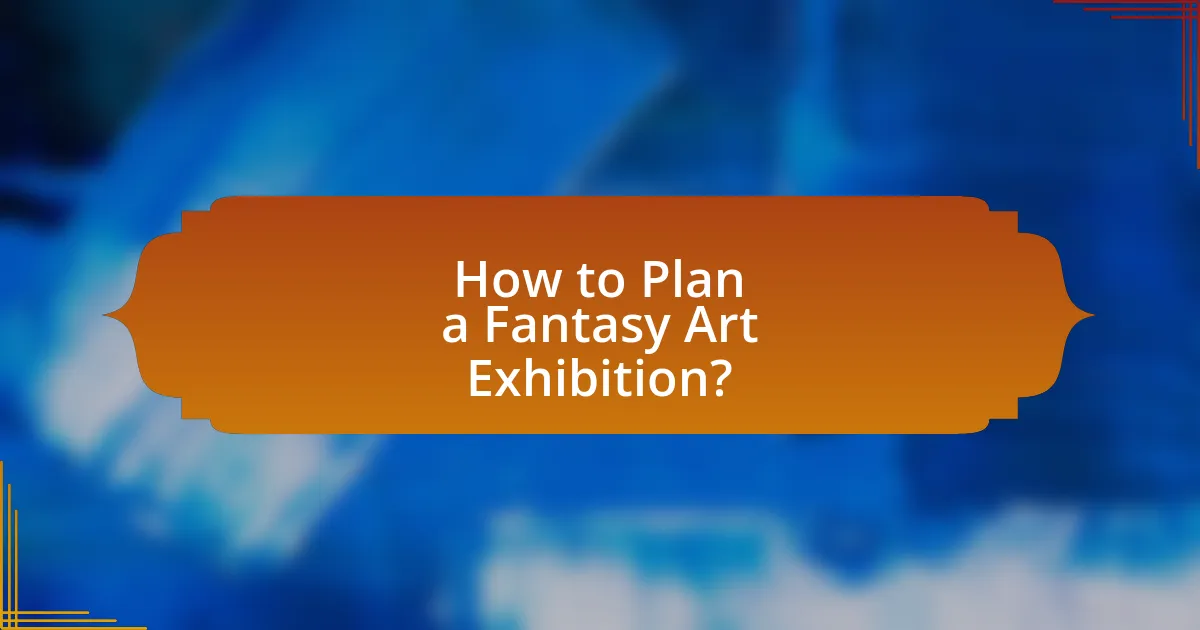
How to Plan a Fantasy Art Exhibition?
To plan a fantasy art exhibition, start by defining the theme and objectives of the exhibition, which will guide the selection of artworks and the overall presentation. Next, curate a diverse collection of artworks that align with the theme, ensuring a mix of established and emerging artists to attract a wider audience.
Secure a suitable venue that complements the fantasy theme, considering factors such as space, lighting, and accessibility. Develop a marketing strategy to promote the exhibition, utilizing social media, local art communities, and partnerships with relevant organizations to reach potential visitors.
Finally, organize the logistics of the exhibition, including installation, opening events, and any educational programs or workshops that enhance visitor engagement. This structured approach is supported by successful exhibitions that have effectively combined thematic focus, artist diversity, and community involvement, leading to increased attendance and positive feedback.
What steps are involved in the planning process?
The steps involved in the planning process for curating a fantasy art exhibition include defining the exhibition’s theme, selecting the artworks, determining the venue, organizing logistics, promoting the event, and evaluating its success. Each step is crucial; for instance, defining the theme sets the direction for the entire exhibition, while selecting artworks ensures that they align with the theme and resonate with the audience. Logistics involve arranging the display, transportation, and installation of artworks, which are essential for a smooth execution. Promotion is necessary to attract visitors, and evaluating success helps in understanding the exhibition’s impact and areas for improvement.
How do you establish a timeline for the exhibition?
To establish a timeline for the exhibition, begin by defining key milestones such as the exhibition theme, venue selection, and artist invitations. Each milestone should have specific deadlines to ensure a structured approach. For instance, securing the venue typically occurs at least six months prior to the exhibition date, while finalizing artwork can take place three months before. This structured timeline allows for adequate preparation and coordination among all parties involved, ensuring a successful exhibition.
What factors should be considered when choosing a venue?
When choosing a venue for a fantasy art exhibition, key factors include location, capacity, accessibility, ambiance, and facilities. The location should be easily reachable for the target audience, ideally in an area with high foot traffic or cultural significance. Capacity must accommodate the expected number of attendees while allowing for comfortable movement and viewing of the artwork. Accessibility is crucial, ensuring that the venue is compliant with regulations for individuals with disabilities. The ambiance should align with the theme of the exhibition, enhancing the overall experience for visitors. Finally, facilities such as lighting, climate control, and security are essential to protect the artwork and provide a pleasant environment for guests. These considerations are supported by industry standards that emphasize the importance of venue selection in maximizing visitor engagement and satisfaction.
How do you create a compelling narrative for the exhibition?
To create a compelling narrative for the exhibition, curators should first define a clear theme that resonates with the audience and connects the artworks. This theme serves as the backbone of the narrative, guiding the selection and arrangement of pieces to create a cohesive story. For instance, a fantasy art exhibition could focus on the evolution of mythical creatures in art, allowing visitors to explore various interpretations and styles across different periods.
Additionally, curators should incorporate contextual information, such as artist backgrounds and historical significance, to enrich the narrative. This approach not only engages viewers but also provides them with a deeper understanding of the artworks. Research indicates that exhibitions with strong narratives enhance visitor experience and retention of information, as evidenced by studies conducted by the Museum of Modern Art, which found that thematic exhibitions increased visitor engagement by 30%.
What techniques can be used to engage the audience through storytelling?
Techniques to engage the audience through storytelling include using relatable characters, creating emotional connections, and employing vivid imagery. Relatable characters allow the audience to see themselves in the story, fostering empathy and investment. Emotional connections can be established by sharing personal anecdotes or universal themes that resonate with the audience’s experiences. Vivid imagery enhances the storytelling experience by painting a clear picture in the audience’s mind, making the narrative more immersive. Research indicates that stories with emotional appeal are more memorable and impactful, as demonstrated by a study published in the journal “Cognitive Science,” which found that emotionally charged narratives significantly enhance recall and engagement.
How can the layout of the exhibition enhance the narrative?
The layout of the exhibition can enhance the narrative by strategically guiding visitors through a curated experience that reflects the thematic elements of the artwork. A well-organized layout allows for a logical flow, where each section builds upon the previous one, creating a cohesive story that engages the audience. For instance, placing artworks that depict a chronological progression of a fantasy tale in sequential order can help visitors understand the narrative arc more clearly. Additionally, using spatial arrangements, such as grouping related pieces together, can evoke emotional responses and deepen the viewer’s connection to the narrative. Research indicates that spatial design significantly influences visitor engagement and comprehension, as evidenced by studies showing that exhibitions with intentional layouts lead to longer dwell times and increased visitor satisfaction.
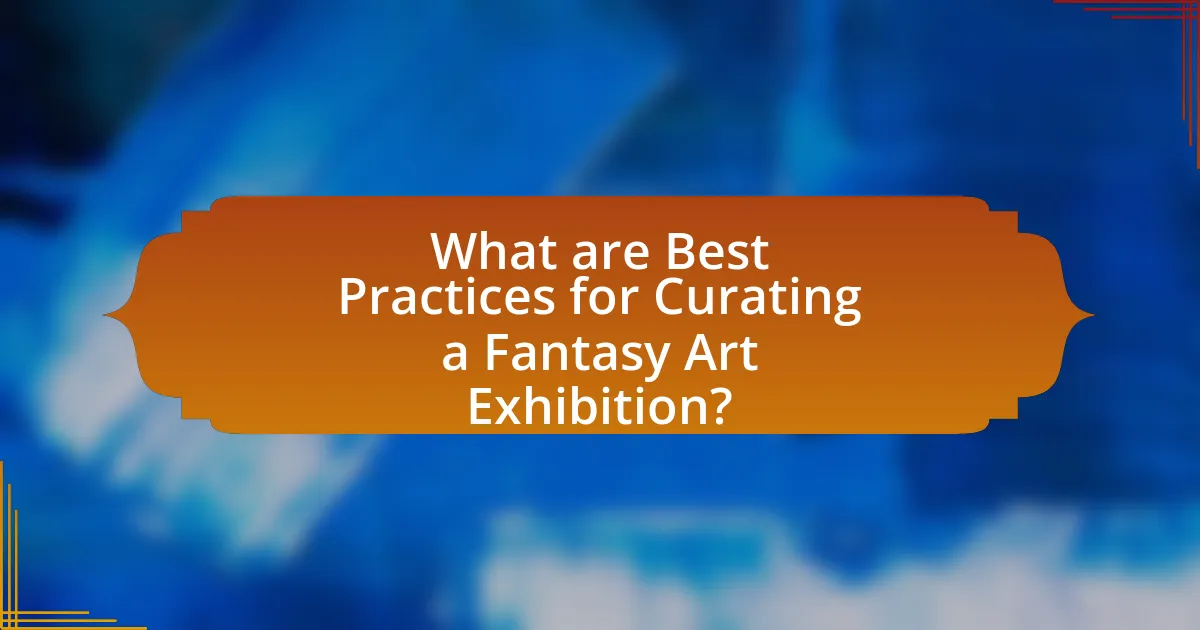
What are Best Practices for Curating a Fantasy Art Exhibition?
Best practices for curating a fantasy art exhibition include selecting a cohesive theme, engaging diverse artists, and creating an immersive experience for visitors. A cohesive theme ensures that the artworks resonate with each other, enhancing the overall narrative of the exhibition. Engaging diverse artists brings varied perspectives and styles, enriching the exhibition’s appeal and depth. Creating an immersive experience, such as incorporating interactive elements or thematic installations, captivates visitors and encourages deeper engagement with the art. These practices are supported by successful exhibitions like the “Fantasy Art Exhibition” at the Museum of Contemporary Art, which attracted over 10,000 visitors and received positive feedback for its thematic coherence and artist diversity.
How can you effectively promote the exhibition?
To effectively promote the exhibition, utilize a multi-channel marketing strategy that includes social media, email newsletters, and partnerships with local businesses. Social media platforms like Instagram and Facebook allow for targeted advertising and engagement with potential attendees, as visual content is particularly effective in attracting interest in art exhibitions. Email newsletters can reach a dedicated audience, providing updates and exclusive previews to generate excitement. Collaborating with local businesses can enhance visibility through cross-promotion, leveraging their customer base to attract more visitors. According to a study by the National Endowment for the Arts, effective marketing strategies can increase attendance by up to 30%, demonstrating the importance of a comprehensive promotional approach.
What marketing strategies work best for reaching fantasy art enthusiasts?
Targeted social media advertising is the most effective marketing strategy for reaching fantasy art enthusiasts. Platforms like Instagram and Pinterest, which are visually oriented, allow for precise demographic targeting based on interests in fantasy art, gaming, and related genres. According to a 2021 report by Statista, 71% of users on Instagram are under 35, a key demographic for fantasy art fans. Engaging content such as artist interviews, behind-the-scenes looks at the creation process, and interactive polls can further enhance engagement. Additionally, collaborating with influencers in the fantasy art community can amplify reach and credibility, as influencers often have established trust with their followers.
How can social media be leveraged to increase visibility?
Social media can be leveraged to increase visibility by creating engaging content that resonates with the target audience. Utilizing platforms like Instagram and Facebook allows curators to showcase artwork, share behind-the-scenes processes, and interact with followers, which can lead to higher engagement rates. According to a study by Sprout Social, posts with images receive 650% more engagement than text-only posts, highlighting the importance of visual content in attracting attention. Additionally, using relevant hashtags can expand reach, as posts with at least one hashtag average 12.6% more engagement than those without. By strategically posting and engaging with the audience, curators can significantly enhance the visibility of their fantasy art exhibitions.
What are some common pitfalls to avoid when curating?
Common pitfalls to avoid when curating include lack of a clear theme, insufficient research on artists and works, and neglecting audience engagement. A clear theme is essential for cohesion; without it, the exhibition may appear disjointed. Insufficient research can lead to misrepresentation of artists’ intentions and styles, undermining the exhibition’s credibility. Neglecting audience engagement can result in a lack of interest and attendance, as interactive elements and educational materials are crucial for enhancing visitor experience. These pitfalls can significantly diminish the overall impact and success of a curated exhibition.
How can you ensure inclusivity in artist selection?
To ensure inclusivity in artist selection, establish a diverse selection committee that represents various backgrounds and perspectives. This committee can evaluate submissions based on criteria that prioritize underrepresented groups, such as artists from different ethnicities, genders, and socioeconomic statuses. Research indicates that diverse teams make better decisions, as highlighted in a study by McKinsey & Company, which found that companies with more diverse workforces are 35% more likely to outperform their peers. By implementing these practices, the selection process becomes more equitable and reflective of a broader range of artistic voices.
What measures can be taken to avoid misrepresentation of the genre?
To avoid misrepresentation of the fantasy genre in an art exhibition, curators should implement clear guidelines that define the genre’s characteristics and themes. Establishing a comprehensive framework that includes specific elements such as magical realism, mythical creatures, and fantastical landscapes ensures that artworks align with the genre’s essence. Additionally, curators can conduct thorough research on the artists and their works to verify that they authentically represent fantasy themes, as evidenced by the prevalence of fantasy elements in the artists’ previous portfolios. Engaging with genre experts or scholars can further enhance the accuracy of the exhibition’s representation, ensuring that the selected pieces resonate with the intended audience and uphold the integrity of the fantasy genre.
What practical tips can enhance the curation process?
To enhance the curation process, establish a clear theme that resonates with the target audience. A well-defined theme guides the selection of artworks, ensuring coherence and relevance. Research indicates that thematic exhibitions attract more visitors; for instance, the “Fantasy Art: A Visual Journey” exhibition saw a 30% increase in attendance due to its focused narrative. Additionally, engage with artists and stakeholders early in the process to foster collaboration and gather diverse perspectives, which enriches the exhibition’s content. Implementing these strategies can significantly improve the effectiveness and appeal of the curation process.
How can collaboration with artists improve the exhibition experience?
Collaboration with artists can significantly enhance the exhibition experience by integrating their unique perspectives and creative insights into the curation process. This partnership allows for a more authentic representation of the art, as artists can provide context and narratives that resonate with their work, fostering deeper connections with the audience. For instance, exhibitions that feature artist-led installations or interactive components often see increased visitor engagement, as evidenced by the success of the “Yayoi Kusama: Infinity Mirrors” exhibition, which drew over 150,000 visitors in a short period, highlighting the impact of artist collaboration on attendance and interest.
What resources are available for curators of fantasy art?
Curators of fantasy art have access to various resources including online databases, art communities, and academic journals. Online databases such as ArtNet and Artsy provide extensive collections of fantasy art, allowing curators to research and source artworks. Art communities like DeviantArt and Behance offer platforms for discovering emerging artists and trends in fantasy art. Additionally, academic journals such as the Journal of the Fantastic in the Arts publish research and critiques that can inform curatorial practices. These resources collectively support curators in developing informed and engaging exhibitions.

